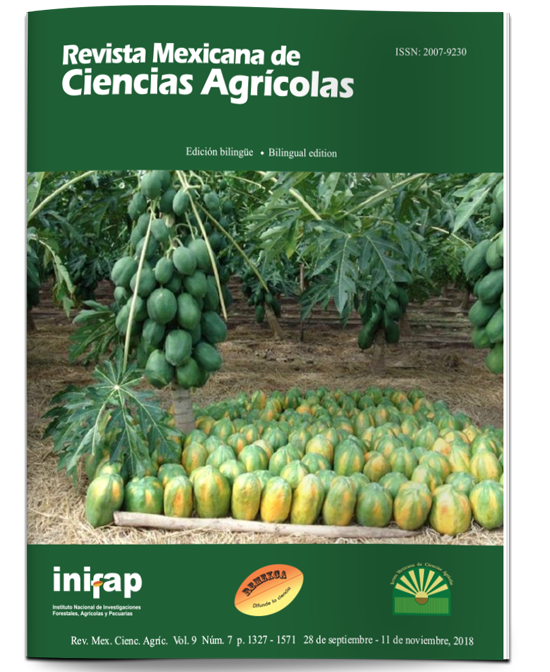Potential geographical distribution of papaya wild cultivated in Mexico
DOI:
https://doi.org/10.29312/remexca.v9i7.550Keywords:
maxent, phytogenetic resource, potential distributionAbstract
The wild populations of papaya (Carica papaya L.) integrate a biological resource for the genetic improvement of the species. The prediction of the geographical distribution of wild and cultivated populations is a useful tool to determine collection sites for their use and conservation. With the objective of estimating the potential distribution of papaya in Mexico, a database with geo-reference information of wild and cultivated papaya individuals was elaborated, then the maximum entropy algorithm (MaxEnt) was applied with 22 bioclimatic variables as predictors. The total area of potential distribution of the wild specimens was 114 546.5 km2, the high potential areas were located in the Gulf of Mexico (south of Veracruz, Tabasco, Campeche) and on the coast of Chiapas. The cultivated papaya presented a high potential distribution in three zones: south of Veracruz, coast of Chiapas and north of Guerrero, forming 185 396.9 km2. The variables that contributed most in the model to estimate the potential distribution of wild papaya were: average minimum temperature of the coldest period (33%), average annual temperature (20%) and soil moisture regime (13%), for the distribution of cultivars the most important variables were: average minimum temperature of the coldest period (41%), rainiest semester precipitation (19%) and annual precipitation (11%). The environmental factors temperature and rainfall, were common in the prediction of distribution of both types of papaya in Mexico.
Downloads
Downloads
Published
How to Cite
Issue
Section
License
The authors who publish in Revista Mexicana de Ciencias Agrícolas accept the following conditions:
In accordance with copyright laws, Revista Mexicana de Ciencias Agrícolas recognizes and respects the authors’ moral right and ownership of property rights which will be transferred to the journal for dissemination in open access. Invariably, all the authors have to sign a letter of transfer of property rights and of originality of the article to Instituto Nacional de Investigaciones Forestales, Agrícolas y Pecuarias (INIFAP) [National Institute of Forestry, Agricultural and Livestock Research]. The author(s) must pay a fee for the reception of articles before proceeding to editorial review.
All the texts published by Revista Mexicana de Ciencias Agrícolas —with no exception— are distributed under a Creative Commons License Attribution-NonCommercial 4.0 International (CC BY-NC 4.0), which allows third parties to use the publication as long as the work’s authorship and its first publication in this journal are mentioned.
The author(s) can enter into independent and additional contractual agreements for the nonexclusive distribution of the version of the article published in Revista Mexicana de Ciencias Agrícolas (for example include it into an institutional repository or publish it in a book) as long as it is clearly and explicitly indicated that the work was published for the first time in Revista Mexicana de Ciencias Agrícolas.
For all the above, the authors shall send the Letter-transfer of Property Rights for the first publication duly filled in and signed by the author(s). This form must be sent as a PDF file to: revista_atm@yahoo.com.mx; cienciasagricola@inifap.gob.mx; remexca2017@gmail.
This work is licensed under a Creative Commons Attribution-Noncommercial 4.0 International license.



